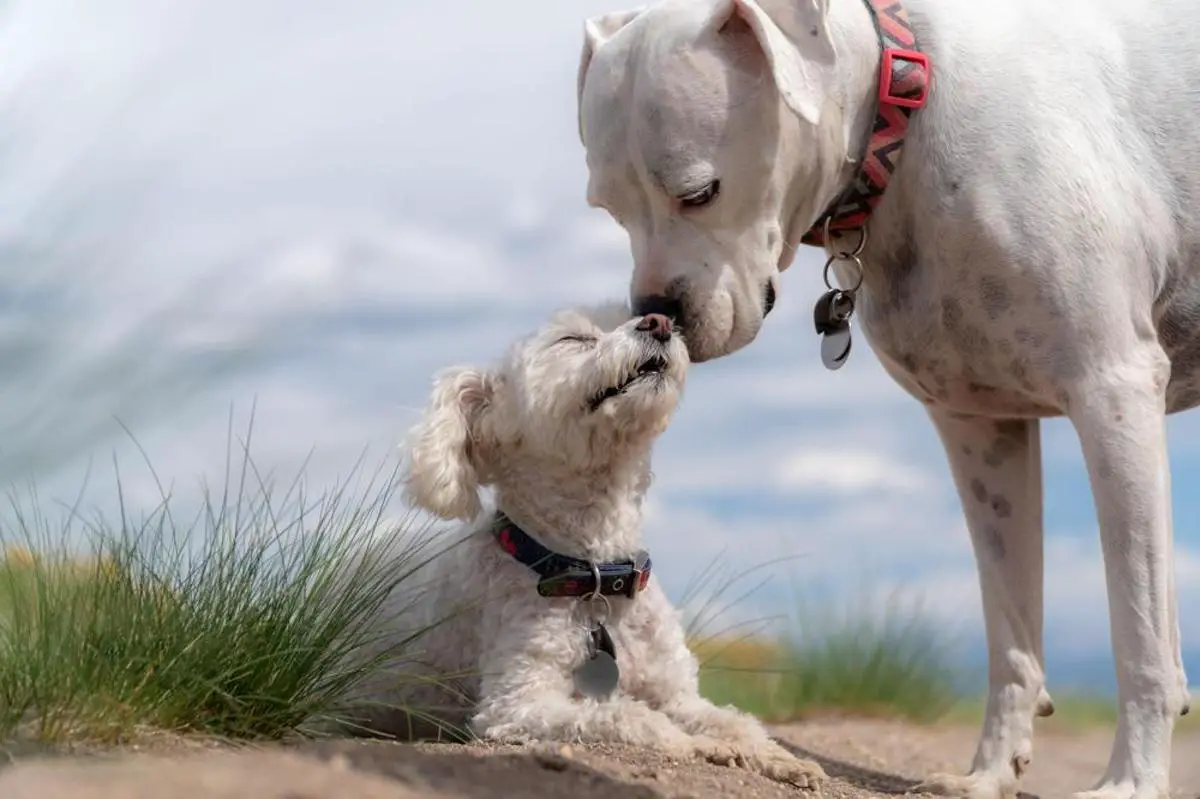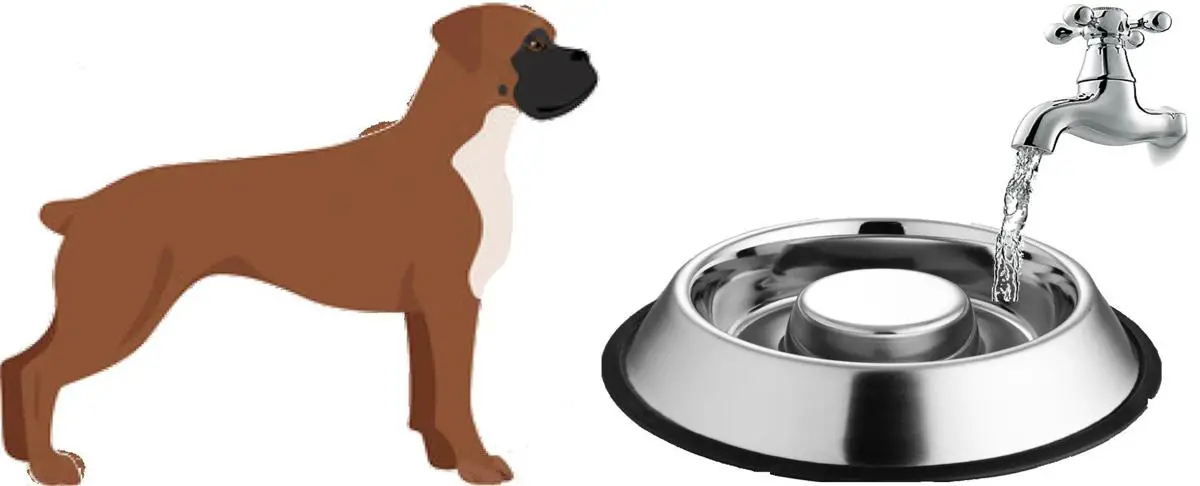Quick Links: Table of Contents
- Boxer Breed Overview
- History of the Boxer Breed. Where Boxers came from
- What the Boxer Looks Like
- How Much is the Boxer Puppy?
- Best Boxer Breeders
- Adopting or Rescuing the Boxer
- Boxer Growth
- What Colors do Boxers Have?
- The Temperament of the Boxer
- How Long Boxers Live
- Boxer Litter Size
- How Fast Boxers Can Run
- Good Names for Boxers
- How Intelligent are Boxers?
- How Popular are Boxers with New Dog Owners?
- Health Problems in Boxers and How to Prevent Them
- How to Take Care of Boxer
- Dog Breeds That Are Similar to Boxers
- Other Things to Know About Boxers
Boxer Breed Overview
The Boxer is a medium-sized dog.
The adult Boxer stands 21 to 25 inches at the shoulder.
The Boxer belongs to the Working Dogs group.
Dogs in the Working Dogs group, like the Boxer, were developed to assist humans in some capacity – including pulling sleds and carts, guarding flocks, guarding homes, and protecting their families.
Breeds in the Working Group are known for their imposing stature, strength, intelligence, and fearless.
Because of their size and strength, working dogs require a structured home life and firm, fair, consistent training by someone who can provide leadership without resorting to anger or physical force.
The fact that the Boxer belongs to the Working Dogs group is one of the reasons why Boxers have the personality and temperament that they have.
The temperament of the Boxer is generally described as:
- Brave
- Bright
- Calm
- Cheerful
- Confident
- Devoted
- Energetic
- Fearless
- Friendly
- Intelligent
- Loyal
- Playful
History of the Boxer Breed. Where Boxers came from
There has been much speculation about the origins of this powerful and compact dog.
Some believe they are descended from the Tibetan Mastiff, a popular fighting dog in the 16th century.
Others claim they are of European origin and are related to the French Dogue de Bordeaux.
Most people believe that the Boxer is a cousin of all Bulldog breeds, ancestors of the Molossoid breed, which was bred for war by the Greco Romans.
These Boxer relatives were prized for their hunting and fighting abilities, which are depicted in 16th and 17th-century Flemish tapestries in scenes of boar and stag hunting.
The modern Boxer was developed in Germany, possibly from two European breeds that are now extinct.
.
What the Boxer Looks Like
The muscular and agile body of the medium-sized Boxer was designed for quick reflexes and strength during hunting and baiting.
Long, sloping shoulders meet a pronounced arched neck, which blends into a straight, short back.
They have a square build due to their straight front legs and curved, broad back thighs.
The chiseled head is in proportion to the body, with wrinkles forming on the forehead when the ears are erect.
Ears can be thin and flat, or they can be cropped.
The breed`s dark brown eyes shine with intelligence.
The breed`s black nose and blunt muzzle have become distinguishing features.
In most cases, the tail is docked.
The coat comprises short, smooth hair that is often shiny in fawn and brindle shades.
.
How Much is the Boxer Puppy?

The average price of a Boxer puppy is $1620. The price of a Boxer puppy ranges from $1200 to $2000.
A lot of factors determine the price of the Boxer. These factors include what health records the Boxer puppy has, the lineage of the Boxer puppy, the US state the breeder is located in, etc.
To estimate how much you can expect to pay for a puppy Boxer based on the many factors that determine the price of the Boxer puppy, check out our calculator that lets you estimate how much you should expect to pay for the Boxer puppy based on what you want in the puppy.
When looking to buy a puppy, look at buying a puppy only from well-established breeders that breed puppies primarily for the love of the Boxer breed, and secondarily for profit. Do not buy a puppy from a puppy mill. Puppy mills mass-produce puppies in bad living conditions for maximum profit.
You may also consider adopting instead of buying a puppy. Adoption costs are very low compared to the price of a puppy.
Best Boxer Breeders

We have researched reputable Boxer breeders that you can buy a puppy.
Go to this page for our complete list of reputable Boxer breeders in various states in the United States.
On this page, you will see how much these breeders sell their puppies for, and how many puppies they have available.
A few of these breeders are listed below.
SAAM Dogs
Puppy Price: $1000
Mary Bontrager
Puppy Price: $900.00
Benjamin Ruth
Puppy Price: $1500.00
Todd and Jen Motter
Puppy Price: $800
MINA menz
Puppy Price: $1000
Adopting or Rescuing the Boxer
You may consider adopting a dog instead of buying a puppy. Many dogs, Boxers included, are currently available for adoption in your local dog shelters.
These helpless but adorable dogs are waiting in dog shelters hoping that someday someone will rescue them. Dog adoption costs are lesser than the cost of a new puppy. Dog adoption costs are usually around $300 or even less.
In addition to your local dog shelter, another good place to find dogs that are available for adoption is petfinder.com.
Below is an adorable Male Boxer named D22-1997 that is currently available for adoption on Petfinder.com. You can find other lovely Boxers like D22-1997 on pefinder.com.
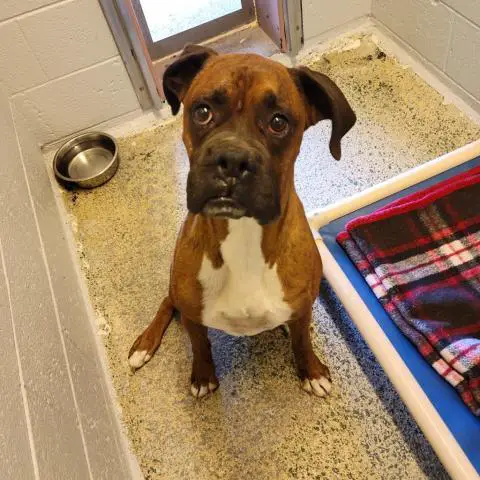
You can find more Boxers that are available for adoption on petfinder.
Boxer Growth

New Boxer owners need to know about the growth of their Boxers. This will help them plan their living spaces accordingly.
Also, knowing the typical growth pattern of the Boxer will help new owners catch the abnormal growth of their Boxer early.
See our calculator for predicting how big your Boxer puppy will get. You will also learn about the typical weight of the Boxer at different ages and how to catch abnormal growth in your Boxer

What Colors do Boxers Have?
Boxers come in the following beautiful primary colors:
- White / Cream
- Brindle
- Yellow / Tan / Blond / Fawn
- Black
- Bicolor
- Brown / Chocolate
- Tricolor (Brown, Black, & White)
- Red / Chestnut / Orange
Boxers come in the following lovely secondary colors in addition to their primary colors:
- Black
- White / Cream
- Brown / Chocolate
- Yellow / Tan / Blond / Fawn
- Tricolor (Brown, Black, & White)
- Brindle
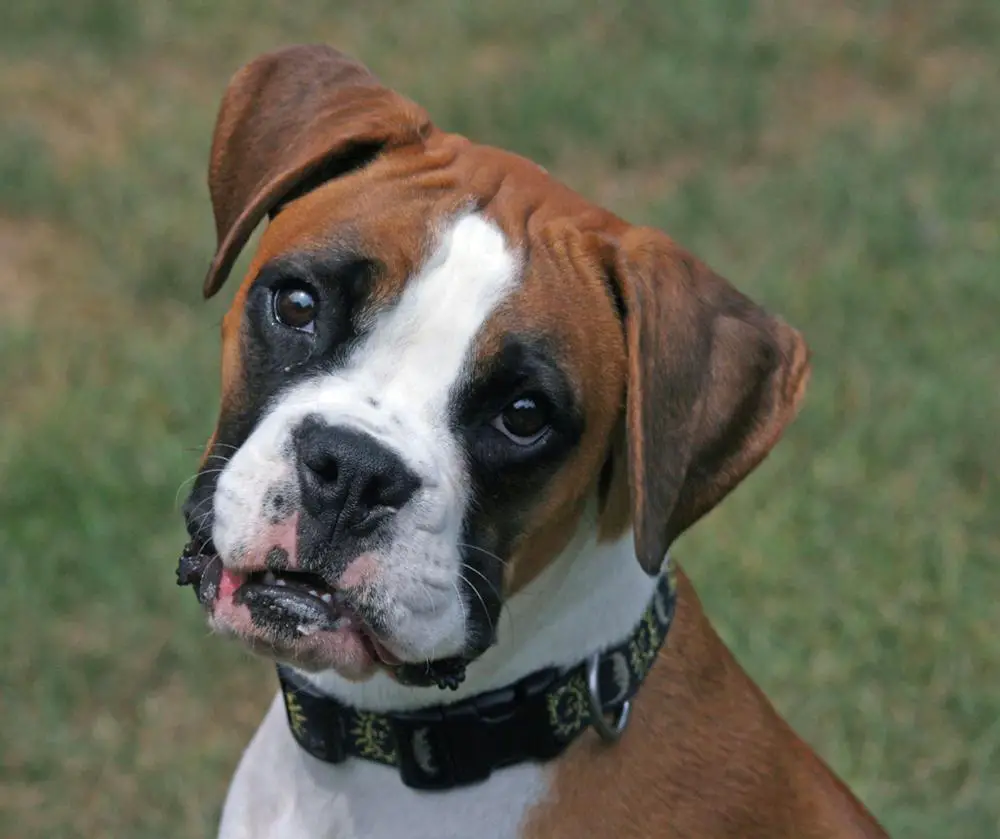
The Temperament of the Boxer
The temperament of the Boxer based can be summarized as in the table below.
The table shows the scores of the Boxer for 13 important dog behavioral factors.
We obtained these scores by analyzing raw data from the C-BARQ dog personality survey tool. The higher the score of a dog for a factor, the worse the temperament of the dog regarding that factor.
The C-BARQ tool was developed by researchers from the University of Pennsylvania, and it is a scientific tool that is used worldwide for reliably measuring the temperament of dog breeds.
See our complete analysis of the temperament of the Boxer here.
| Factor | Score |
|---|---|
| Owner Directed Aggression | 8.5 percent |
| Energy Level | 75.4 percent |
| Dog Directed Aggression | 68.6 percent |
| Excitability | 61.8 percent |
| Attachment Attention Seeking | 55.2 percent |
| Prey Drive | 48.3 percent |
| Stranger Directed Aggression | 41.8 percent |
| Separation Related Behavior | 40.3 percent |
| Nonsocial Fear | 34.5 percent |
| Dog Rivalry | 32.8 percent |
| Stubbornness | 27.7 percent |
| Dog Directed Fear | 27.5 percent |
| Stranger Directed Fear | 27.1 percent |
| Touch Sensitivity | 15.4 percent |
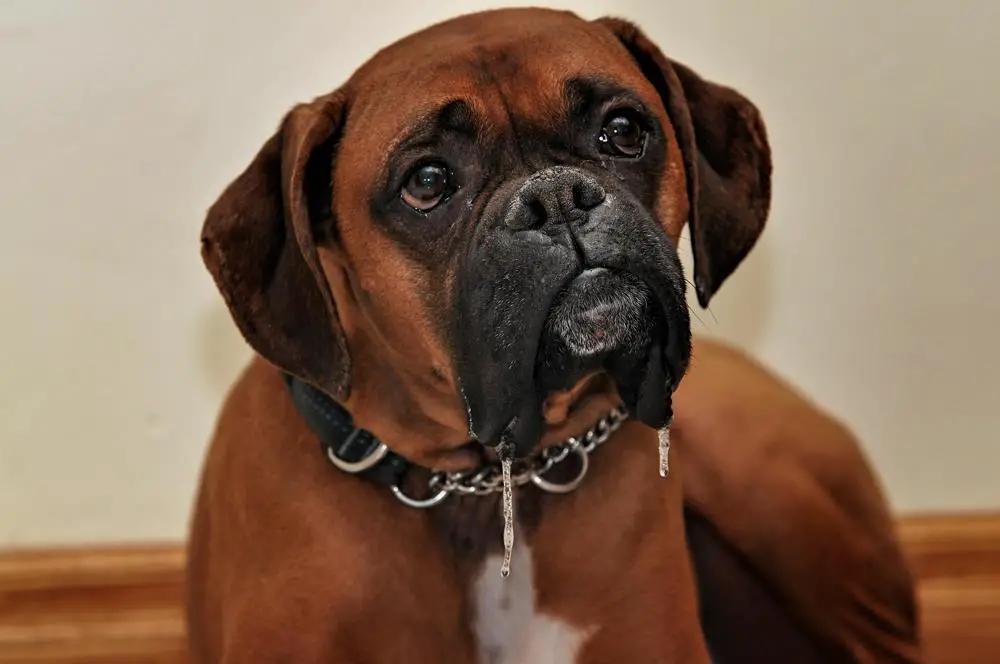
How Long Boxers Live
The lifespan of the Boxer is typically from 10 to 12 years.
Moreover, a few years back, veterinarian researchers performed a scientific study to determine the lifespan of the Boxer. In this study, the scientists collected data on how long 130 pet Boxers lived.
From the study, it was found that Boxers have an average lifespan of 10.2 years. Furthermore, the study found that it is not uncommon for Boxers to live as long as 15.2 years.
Note that you need to put in some effort if you want your Boxer to live long.
Boxers live long if they eat well, drink well, exercise well, and visit the veterinarian regularly.
There are also dog supplements that you can give your Boxer to improve your Boxer`s quality of their life.
Click here to learn more about how to make your Boxer live long.
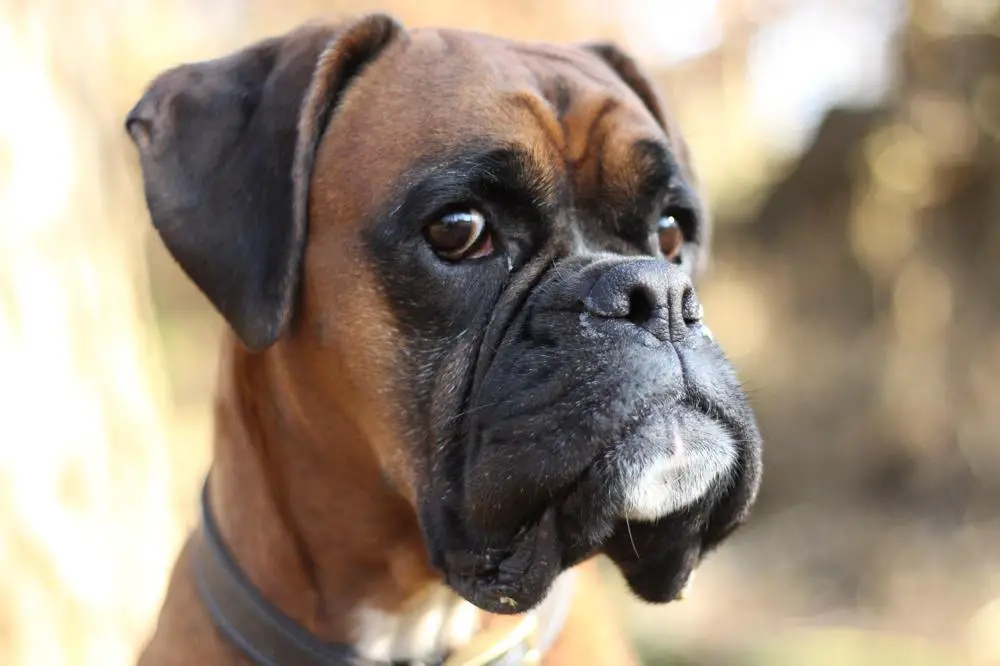
Boxer Litter Size
Researchers from the Norwegian School of Veterinary Science did a study where they counted the numbers of puppies in 139 different Boxer birth litters.
From this study, the researchers found that the average number of puppies that Boxers can have is 6 puppies. Also, the Boxer can have as few as 1 puppies per litter and as many as 12 puppies per litter.
The number of puppies that the Boxer will have depends on factors such as the age of the Boxer, the method of pregnancy, etc.
Click here to see our calculator for predicting how many puppies your Boxer will have and how the litter size of the Boxer compares to the litter size of other dog breeds.
How Fast Boxers Can Run

How fast a dog breed can run is a good measure of how athletic the dog breed is.
The American Kennel Club (AKC) regularly conducts dog running competitions. The AKC records the running speed of competing dogs in these competitions. These competitions are open to all dog breeds.
Based on our analysis of the speeds of 322 different Boxers, the average speed of the Boxer is 25.4 mph (40.9 kmph).
The fastest speed on AKC record that the Boxer ran in a race is 36.14 mph (58.2 kmph) and the minimum speed on record in a race for a Boxer is 11.32 mph (18.2 kmph).
Click here to see how the speed of the Boxer compares to the speed of other dogs and other mammals such as cats, horses, humans, etc.
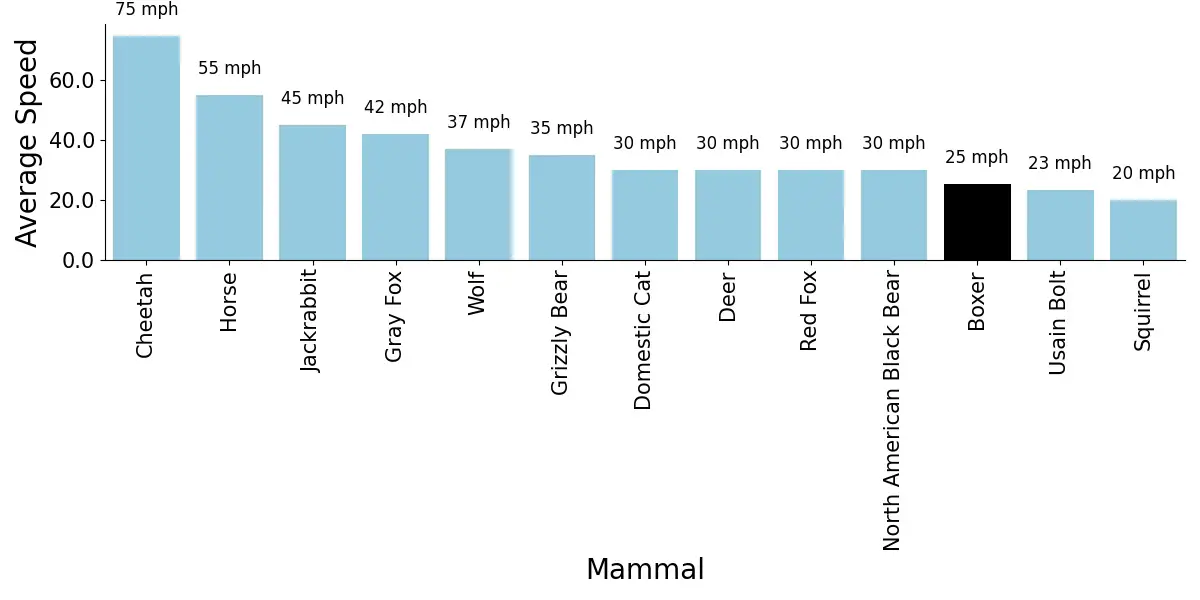
Good Names for Boxers
Here are some really good names that are typical for the Boxer ranked by popularity:
- Dog
- Tank
- Rocky
- Buddy
- Buddy
- King
- Buster
- Bruno
- Max
- Cooper

How Intelligent are Boxers?
| Boxer | |
|---|---|
| Intelligence Rank | 48 out of 130 dog breeds |
| Trainability | Tend To Learn New Commands After 25 To 40 Repetitions |
According to Prof. Stanley Coren, a Canadian psychology professor/dog trainer, the total intelligence that a dog demonstrates is the addition of three types of intelligence. These intelligence types are:
- Instinctive Intelligence: This is the natural intelligence that comes from instinct. For example, dog breeds that have been historically bred to be guard dogs will have a high `guarding` intelligence compared to dogs that were not bred for guarding.
- Adaptive Intelligence (learning and problem-solving ability): This indicates what a dog can learn to do for himself or herself. Adaptive intelligence is specific to each dog, and not breed specific. You can improve your dog`s adaptive intelligence by investing time to train your dog.
- Working/Obedience Intelligence: This type of intelligence is breed-specific. Certain dog breeds tend to have higher working/obedience intelligence than some other breeds. This intelligence is the closest to what we might call school-learning ability and it is based upon what the dog can learn to do when instructed by humans. This type of intelligence can be measured for each dog breed and compared to that of other dog breeds.
Professor Stanley Coren measured and ranked the working intelligence of about 130 different dog breeds.
Prof. Coren found that the Boxer has an obedience intelligence rank of 48 out of 130 dog breeds. Thus, Prof. Coren put Boxers in the `Average Working/Obedience Intelligence Dogs` category.
This means that Boxers tend to learn new commands after 25 to 40 repetitions.
However, we should mention that a dog should not be judged based on its intelligence alone. There are other important factors you need to consider when deciding on which dog breed to get. These other factors include sociability, adorability, and compatibility of the dog breed with your lifestyle.
See the intelligence ranking of some other dog breeds below:
| Breed | Intelligence Rank |
|---|---|
| English Springer Spaniel | 13 |
| Cocker Spaniel | 20 |
| Giant Schnauzer | 28 |
| Airedale Terrier | 29 |
| American Staffordshire Terrier | 34 |
| Norwegian Elkhound | 36 |
| Norwich Terrier | 38 |
| Dalmatian | 39 |
| Bedlington Terrier | 40 |
| Bichon Frise | 45 |
| Scottish Deerhound | 47 |
| Chinese Shar-Pei | 51 |
| Rhodesian Ridgeback | 52 |
| Pug | 57 |
| Great Pyrenees | 64 |
| Bullmastiff | 69 |
| Basset Hound | 71 |
| Beagle | 72 |
| Bloodhound | 74 |
| American Bulldog | 77 |

How Popular are Boxers with New Dog Owners?
Every year, the American Kennel Club (AKC) publishes information on how popular a dog breed is in that particular year. The AKC gets the popularity information of a breed from how many dogs of that breed the owners register with the AKC every year. The AKC collects this data for about 200 dog breeds.
The graph below shows the popularity trend of the Boxer.
The popularity of the Boxer averaged over the years is Number 11 out of about 200 dog breeds.
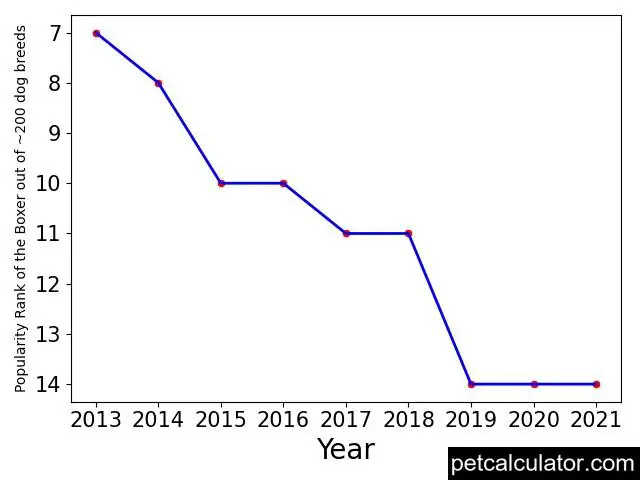
Do not get a dog breed just because it is a popular dog breed. And do not reject a dog breed just because it is an unpopular breed.

Health Problems in Boxers and How to Prevent Them
Every dog breed has its own set of health problems that it tends to develop. There is nothing like a perfect dog breed.
The Boxer is prone to certain genetic health conditions. The Orthopedic Foundation for Animals (OFA) is an organization that keeps track of genetic health problems in dog breeds.
From the extensive records that the OFA keeps, the OFA knows what health problems each dog breed is naturally prone to develop.
Hence, the OFA recommends which health screening breeders should perform on a dog breed to make sure that the breeders won`t breed `defective` dog parents that can pass down defective genes to their puppy offspring.
If you want a Boxer puppy that will grow up to be healthy, make sure that your Boxer breeder screens your puppy or your puppy`s parents for the health problems that the OFA recommends for your puppy`s breed. This will increase the chances that your puppy is free from genetic defects.
The following are the health tests that Orthopedic Foundation for Animals (OFA) recommends that breeders should screen Boxers for:
You can find out more about OFA`s recommended tests for Boxers here.

How to Take Care of Boxer
To take good care of your Boxer, you need to make sure that you groom your Boxer regularly.
Secondly, you need to find a veterinarian in your area that will routinely check the health status of your Boxer regularly, and give you appropriate recommendations on your Boxer`s preventative care.
Thirdly, you need to commit some time to exercise your Boxer daily. Regular exercise helps improve the health and quality of life of your Boxer.
Also, you need to feed your Boxer high-quality dog food, and the food should be of the right amount to prevent your Boxer from getting overweight or underweight.
See our recommendations on what to feed the Boxer and how much food to feed the Boxer at different life stages.
Finally, you need to make sure that your Boxer has access to clean water all the time. See our recommendations on how much water your Boxer needs to drink at different ages.
Dog Breeds That Are Similar to Boxers
If you have not made up your mind on which dog breed to get, you may also want to consider some other dogs similar to the Boxer.
We crunched the numbers and found that the following dog breeds that have similar behavior and temperament as the Boxer:
- Rottweiler (75 percent match with Boxer). Learn more about the Rottweiler here.
- Valley Bulldog (80 percent match with Boxer). Learn more about the Valley Bulldog here.

Other Things to Know About Boxers
Here are some of the very important characteristics of the Boxer that you need to know about the Boxer breed:
